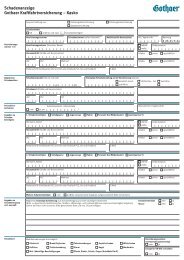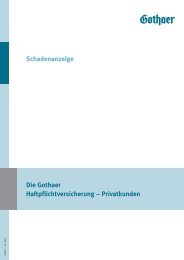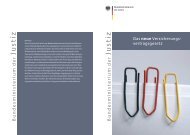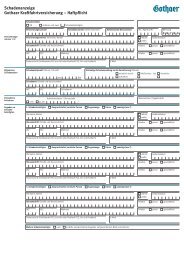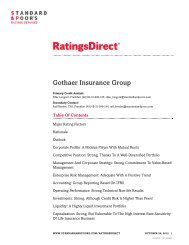01 Gothaer Konzern_E_09_Umschl - Gothaer Allgemeine ...
01 Gothaer Konzern_E_09_Umschl - Gothaer Allgemeine ...
01 Gothaer Konzern_E_09_Umschl - Gothaer Allgemeine ...
Create successful ePaper yourself
Turn your PDF publications into a flip-book with our unique Google optimized e-Paper software.
Management Report<br />
Counterparty<br />
default risk<br />
Interest-bearing<br />
financial instruments<br />
Counterparty default risk is the risk that arises as a result of default or as a result of a<br />
change in the credit rating or assessment of creditworthiness (credit spread) of security<br />
issuers, counterparties and other debtors with accounts payable. In addition to regulatory<br />
monitoring, counterparty default risk is limited and monitored by reference to internal<br />
investment ceilings.<br />
For risk management purposes, the acquisition of any investment vehicle is permissible<br />
only if a qualified assessment of creditworthiness by an external agency such as<br />
Standard & Poor’s or Moody’s or a qualified internal rating is available. Internal ratings<br />
are used only where no rating has been issued by an external agency. Credit risks are<br />
broadly spread to avoid concentration risks. All investments are constantly monitored in<br />
this regard on the basis of regulatory requirements.<br />
The interest-bearing financial instruments held by the insurance carriers in the <strong>Gothaer</strong><br />
Group are divided into two categories for risk management purposes: “liquidity” and<br />
“credit”. The distinction here is whether an instrument presents only an interest risk or<br />
whether an additional credit risk exists because of the solvency of the issuer. So where<br />
a financial instrument entails no or only a minimal default risk, it is assigned to the<br />
“liquidity” category. This is the case, for example, with German government bonds<br />
(bunds) and senior secured covered bonds (pfandbriefe). The balance sheet book values<br />
of our interest-bearing financial instruments can be regarded as an equivalent for the<br />
maximum default risk of the <strong>Gothaer</strong> Group.<br />
The table below shows the market value of interest-bearing financial instruments<br />
assigned to the “liquidity” and “credit” categories by rating class, as managed and<br />
monitored in the <strong>Gothaer</strong> Group. Retail funds are not included.<br />
Breakdown by rating category Share in %<br />
20<strong>09</strong> 2008<br />
AAA 45.7 48.3<br />
AA+ 7.3 5.0<br />
AA 3.3 3.2<br />
AA– 6.1 9.7<br />
A+ 5.6 4.8<br />
A 7.2 9.7<br />
A– 6.0 5.0<br />
BBB+ 5.7 5.1<br />
BBB 2.3 2.6<br />
BBB– 3.9 1.7<br />
Speculative grade (BB+ to D) 5.8 3.6<br />
Non-rated 1.0 1.3<br />
The diagram below shows the market value of the financial instruments assigned to the<br />
“liquidity” and “credit” categories.<br />
80 <strong>Gothaer</strong> Group Annual Report 20<strong>09</strong>








